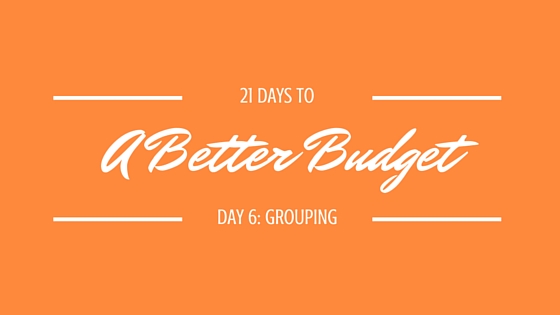
Today we’re talking about how to begin moving from tracking to budgeting.
By tracking your spending, you are creating a record of what you have done with your money in the past; by budgeting, you are creating a plan for what you are going to do with your money in the future.
Tracking lets you know how you are doing right now with your money; budgeting is how you start to do better.
Remember yesterday when I told you about Budget Math? Let’s refresh:
X – Y = $0
X is income. Y is your expenses (including savings).
They should match – every single dollar you bring into your home, should get spent or saved for later.
If you just started tracking for the first time every on Monday, it’s possible you’re not sure what your equation looks like. That’s okay. Keep doing what you’re doing.
In order to build a budget, the first thing you need to do is work your way through your list of tracked expenses and begin to group them together.
Spoiler alert: These groups will become what we call categories in your budget. But more on that on Monday.
Click Here to Subscribe to the FREE 21 Days to a Better Budget Newsletter
Which is better? More detailed or more general?
Some people like to make lots of little groups – one for every specific type of item or purchase. I, on the other hand, tend toward a less-is-more approach. I group like items together to make my forecasting and tracking simpler. I find that this method saves me time and frustration.
Here is an example: I have a group of expenses called “Groceries”. It covers food items, of course; but it also covers household items like laundry detergent and toilet paper, toiletries and other personal care items. When we had kiddos in diapers, diapers and wipes came out of that category, too.
I made this broader gorup after realizing that every trip to Target or Costco resulted in hair-pulling frustration as I tried to figure out how to divide up the receipt for my tracking. Did this item belong in groceries? Toiletries? Household products? Yikes! Having one broader group streamlines the tracking process – and connects it to the store I’m shopping at (in my case, that’s usually a grocery store, drug store, Costco or Target), rather than the specific item I’m buying.
The one downside to broader categories
The only downside I can see to the broader approach is if you have run-away spending. By that I mean one area in which you are consistently overspending.
Take “Groceries” for example. If your budget (which we will be creating in detail next week) calls for you to spend $700 and your tracking shows you that you’re regularly spending 1.5 – 2 times that, the broadness of the category may make it challenging to drill down and figure out exactly what’s going wrong – and how to fix it. Are you spending too much on food? Should you be cutting back on personal care items? Is it something else? All of the above?
If you start to notice run-away spending, you can always divide out that category again and make smaller categories (or even sub-categories) in the future. Start simple, get fancy later.
This weekend’s homework assignment
But let’s not get ahead of ourselves. Your homework for the weekend is to review your tracking data (the more you have, the better!) and begin to group like expenses together. This way you will have a broader picture of where your money is currently going.
Those of you who began tracking on Monday for the first time ever may find that you don’t have enough data points yet to complete this assignment. That’s okay – just keep on tracking and save this email so that when you’re ready, you can jump back in.
If you have missed any of the previous installments, or you want to go back and read them again, they are all archived HERE for your convenience.
Click Here to Subscribe to the FREE 21 Days to a Better Budget Newsletter















Leave a Comment